Upholding cultural traditions in Tonga
IFAD Asset Request Portlet
Asset Publisher
Upholding cultural traditions in Tonga
Sustaining handicraft livelihoods through community-driven development
04 March 2021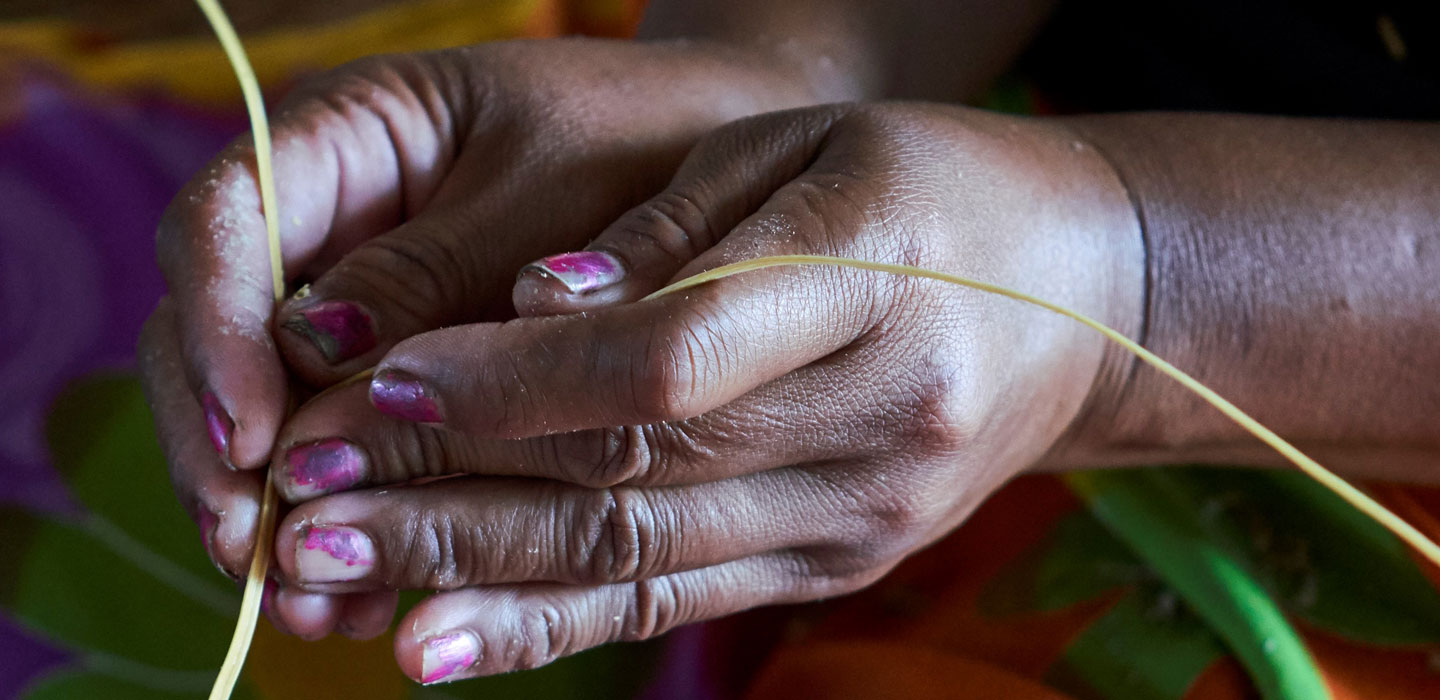
An old Tongan proverb says that a successful village lives together, works together, and helps one another. This is especially true for handicrafts, an integral part of traditional Tongan culture.
For millennia, Tongan women have passed the arts of weaving and ngatu (making cloth from mulberry tree bark) from generation to generation. They nurture, gather and prepare the natural resources needed to make these handicrafts, then create them in communal weaving huts.
The woven mats, baskets and ngatu made in these huts are traditionally gifted to commemorate births, marriages and deaths. They are symbols of social status and are often part of a family’s most treasured heirlooms. Some women also make these handicrafts to sell – and they are often major contributors to household income.
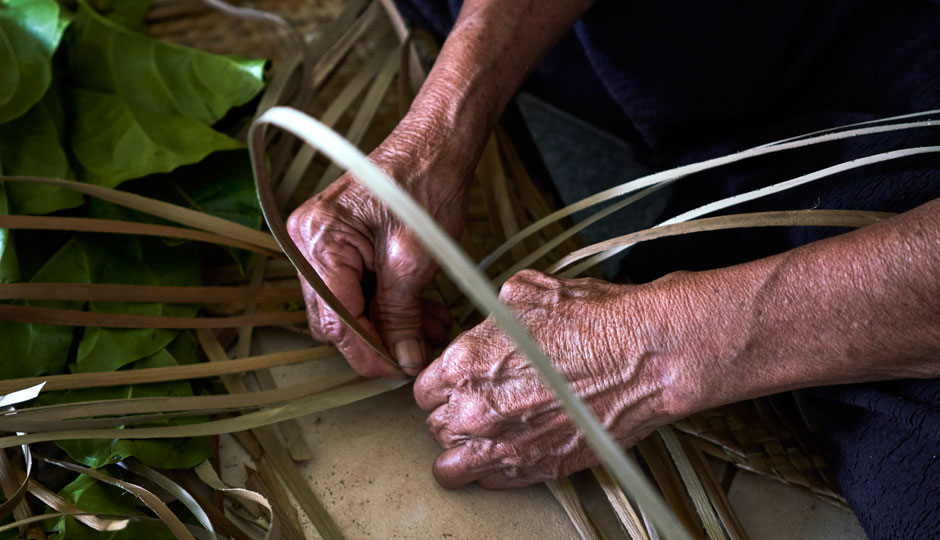 |
| ©IFAD/ Todd M. Henry |
IFAD is committed both to safeguarding the social identity of Tongan communities and to strengthening the sustainability of handicrafts as an important livelihood and fundamental aspect of anga fakatonga – the Tongan way of life. To capture this sense of sharing and social responsibility, IFAD designed the TRIP II programme.
IFAD has a long history of supporting community-driven development projects, helping people collectively take control of planning decisions. With IFAD’s support, the MORDI Tonga Trust, the local organization in charge of implementing TRIP II, hosts planning sessions and skill trainings in 122 rural communities throughout the archipelago’s 36 inhabited islands, empowering local residents to define and carry out their development goals. It is no surprise that women identified the need for improved shared workspaces for their handicrafts as a top development priority.
In partnership with IFAD and the New Zealand Aid Programme, MORDI Tonga Trust is developing climate-resilient infrastructure and strengthening sustainable livelihoods by rebuilding or constructing multi-purpose community halls. In addition to functioning as comfortable workspaces, these halls can withstand category 5 tropical cyclones, offering places of safe refuge to the local community. And the roofs collect rainwater runoff in water tanks, providing a source of clean drinking water for communities to share during periods of drought.
'Eua is one of Tonga’s 36 inhabited islands and home to about 5,000 people spread across 15 communities, each with its own hall. The women introduced in the following photographs use the community halls for many purposes – but most importantly, as a workspace where they meet to make the handicrafts that are so important to their traditional societal values and livelihoods.
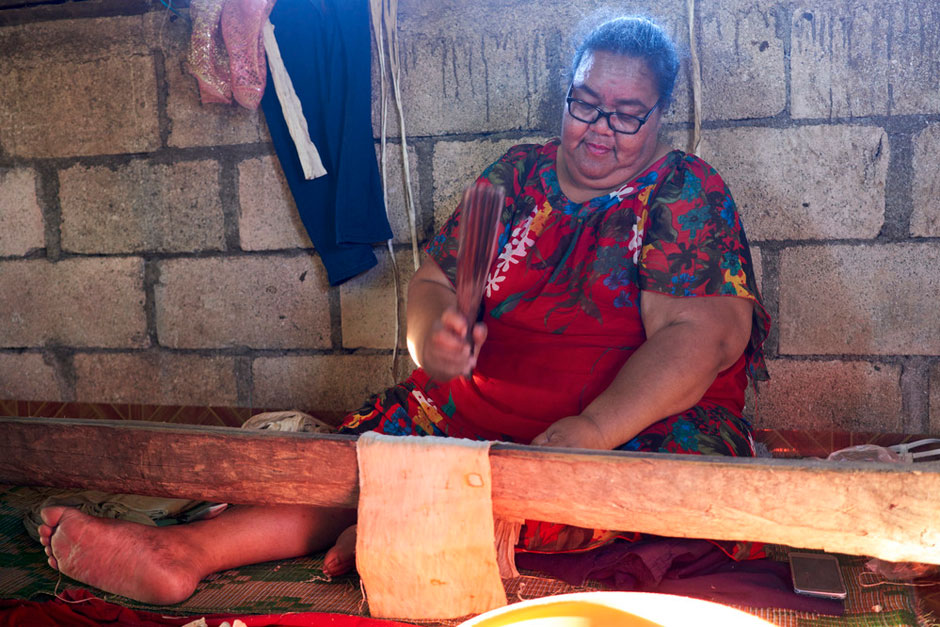 |
| Olive makes ngatu cloths in Angaha Community, 'Eua. ©IFAD/ Todd M. Henry |
Olive Kata, like many women in the small communities on ‘Eua and across Tonga, spends much of her time making cloth pieces that will be used to make ngatu. Through TRIP II’s farmer field school active on the island, Olive and other women are learning sustainable production methods from agricultural extension agents to ensure that the mulberry trees and other natural resources they need to produce their handicrafts continue to flourish.
The cloth-making process requires time, skill and a lot of patience. “I grow a few mulberry trees in my garden,” explains Olive. “I cut branches from the tree when they are two or three years old and let them dry for a couple of days in the sun. Then I strip the outer layer of bark off the branches to get to the soft inner layer of bark. I remove it from the branch and soak it in water overnight. The next day, it is ready for me to use.”
Olive joins an orchestra of women across the island, rhythmically pounding the soft, cream-coloured inner bark with an ike, or wooden mallet, into paper-thin pieces. Each woman in her work group contributes a pre-determined number of cloths and, together, they glue the many pieces together with a natural paste made from cassava root to assemble a large expanse of ngatu.
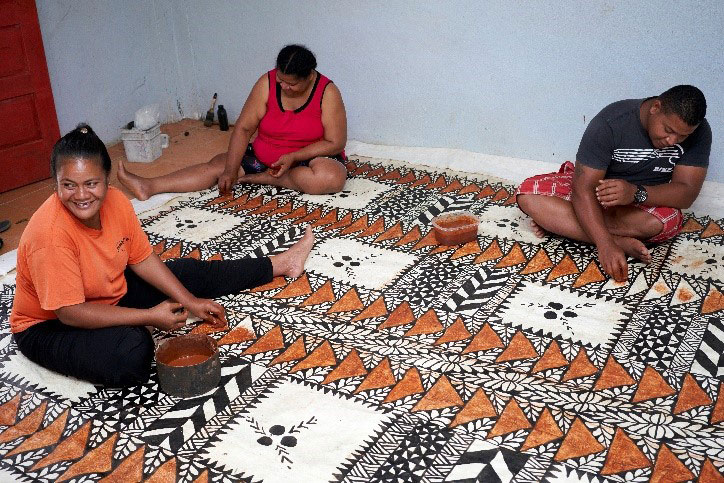 |
| 'Alavina (left) joins Linalose (middle) and Hauloto (right) to paint kupesi designs on ngatu in Fata’ulua Community Hall. |
Each piece of ngatu is unique, because it’s entirely made by hand. Depending on the quality of artisanship, the larger pieces, which can measure as much as 50x100 feet (15x30 meters), can sell for US$1,500 or more.
‘Alavina Siale joins other women – and occasionally men – in the Fata’ulua community hall to assemble and decorate their ngatu with traditional kupesi designs, such as leaves, animals and geometric figures.
“We use black and brown colours that we get from tree bark, earth and roots,” says ‘Alavina. “Traditionally we used the root from the mangrove tree for dye. But these days, we are using mud from around the roots instead.” The farmer field school is helping islanders protect mangrove swamps, which serve as a protective barrier against cyclones, and to sustain production of the other plants they use to make dyes.
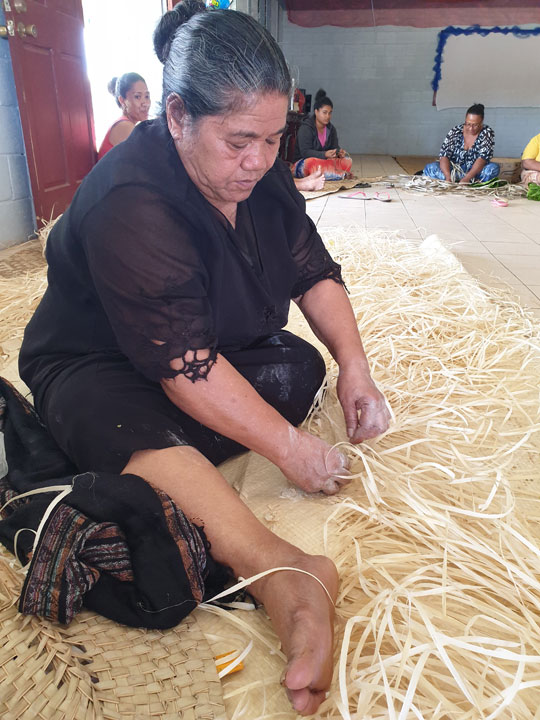 |
| Loisi weaves a traditional Tongan fala from pandanus leaves in Mu'a Community Hall. ©IFAD/ Bob Baber |
Mat weaving is another ancient handicraft of great significance in Tongan culture. Tongans use mats for a variety of purposes in their everyday lives, ranging from bedding and flooring to ta'ovala, which they wear wrapped around the waist as a formal accessory. These woven items are often the most treasured possessions in Tongan households, passed down from generation to generation.
Most days, Loisi Kaafi gathers with a small group of women at the Mu’a community hall. “We help each other with the weaving, and pass the days working and chatting together,” she says.
Mats take a lot of time and a great deal of skill to make. They’re woven from the leaves of the wild-growing pandanus plant. Before the weaving can even begin, several days are needed just to prepare the thorny pandanus leaves.
“It takes me several days to weave a large mat. But, a fala – a finely woven one – can take weeks to complete,” Loisi explains. Depending on the size, type of weaving and quality, a woven product sells anywhere between a few dollars to well over US$1,000.
As climate change affects agricultural production through the increased frequency and intensity of droughts and tropical cyclones, households rely more and more on the money made from weaving. Pandanus is indigenous to the tropical Pacific Islands, with various species of the plant growing in coastal areas of the islands – but lately, it is in short supply. The project is working with the islanders to maintain a sustainable yield of fibre crops, including pandanus, to preserve the local species.
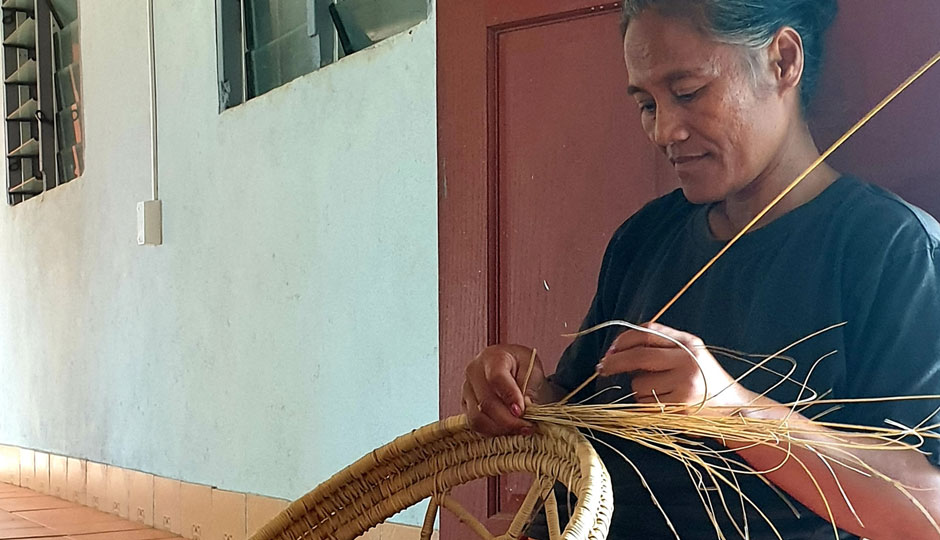 |
| Sela weaves a traditional Tongan kato'alu basket in the recently renovated Petani Community Hall, ‘Eua. ©IFAD/ Bob Baber |
The kato’alu is a woven ceremonial basket said to originate from the island of 'Eua. Today, Sela Fifita is one of only a very few women who still know the lengthy, detailed production process and the complex techniques needed to weave it. She starts by gathering and carefully preparing the roots of the relatively rare and slow-growing alu plant. These days, alu is found only on ‘Eua island, as primary rainforests have disappeared elsewhere throughout the archipelago.
Specialized knowledge of weaving the kato’alu is rapidly disappearing from Tonga, perhaps because of a continual loss of interest in traditional ways among young people. Sela’s nine-year-old daughter Teotora (Deborah) stays with her at the hall during school breaks or joins her there after class on school days. Although she takes some time to play with the other children, she’s also learning to weave these baskets from Sela – giving hope that this culturally valuable craft will survive for at least another generation.
Learn more about IFAD’s work in Tonga